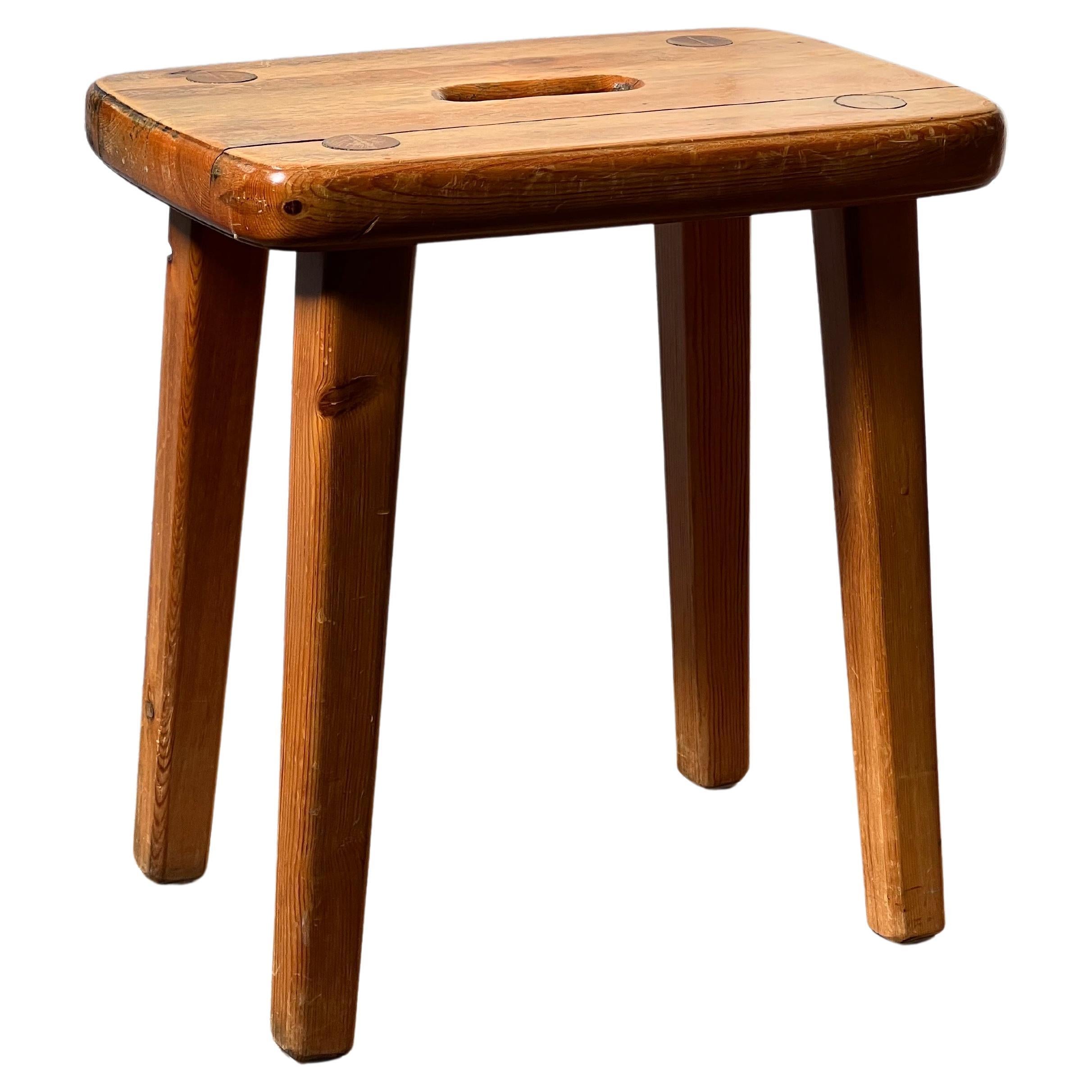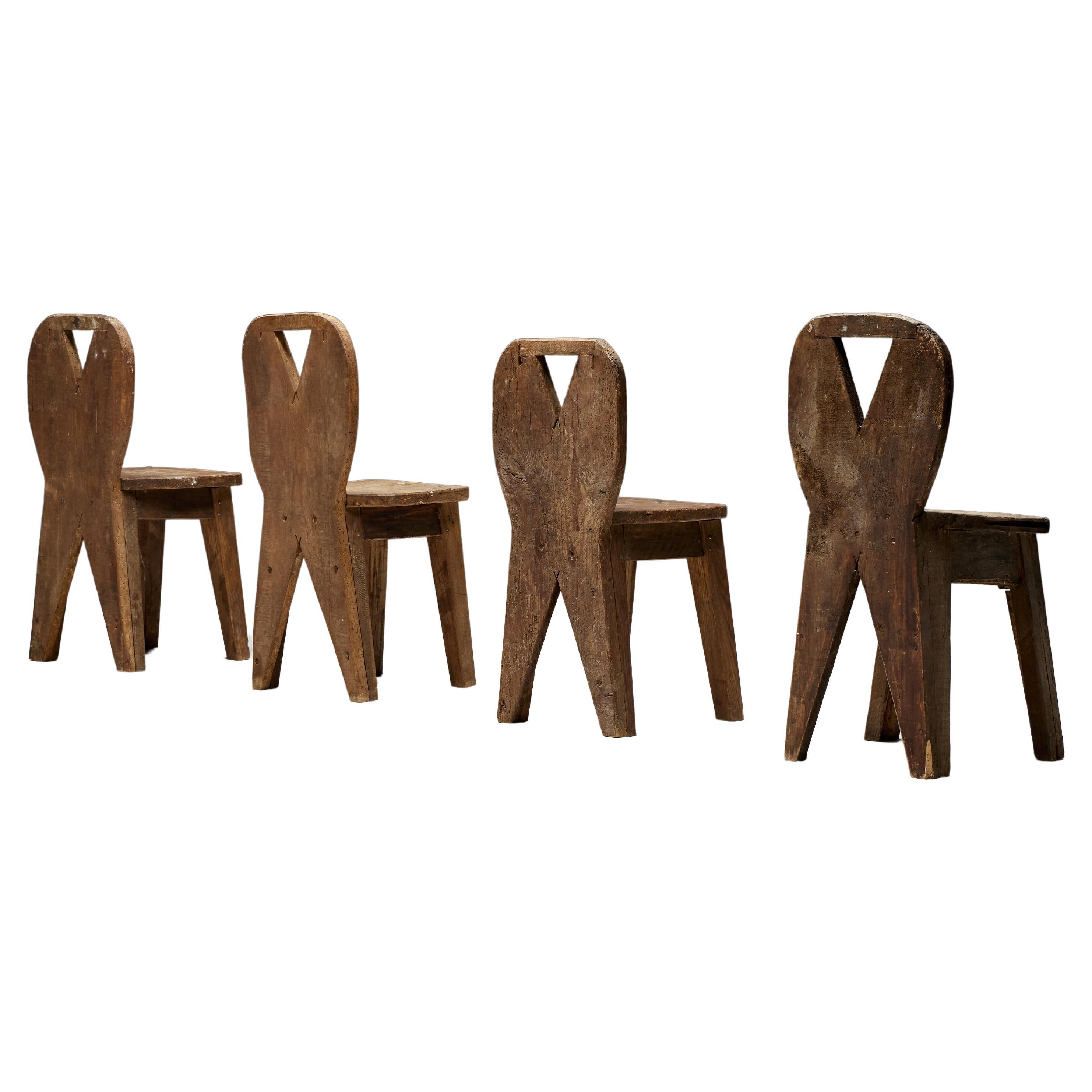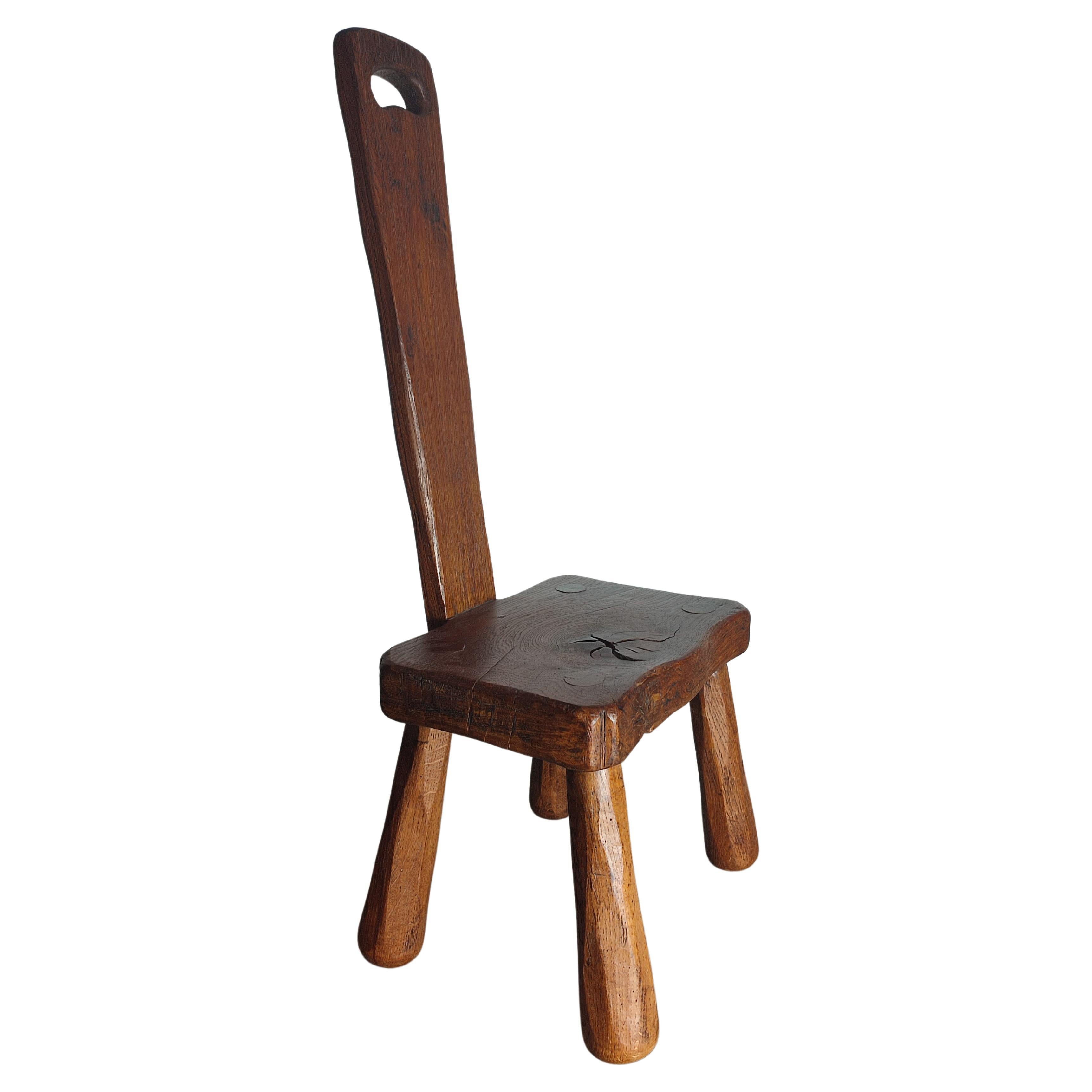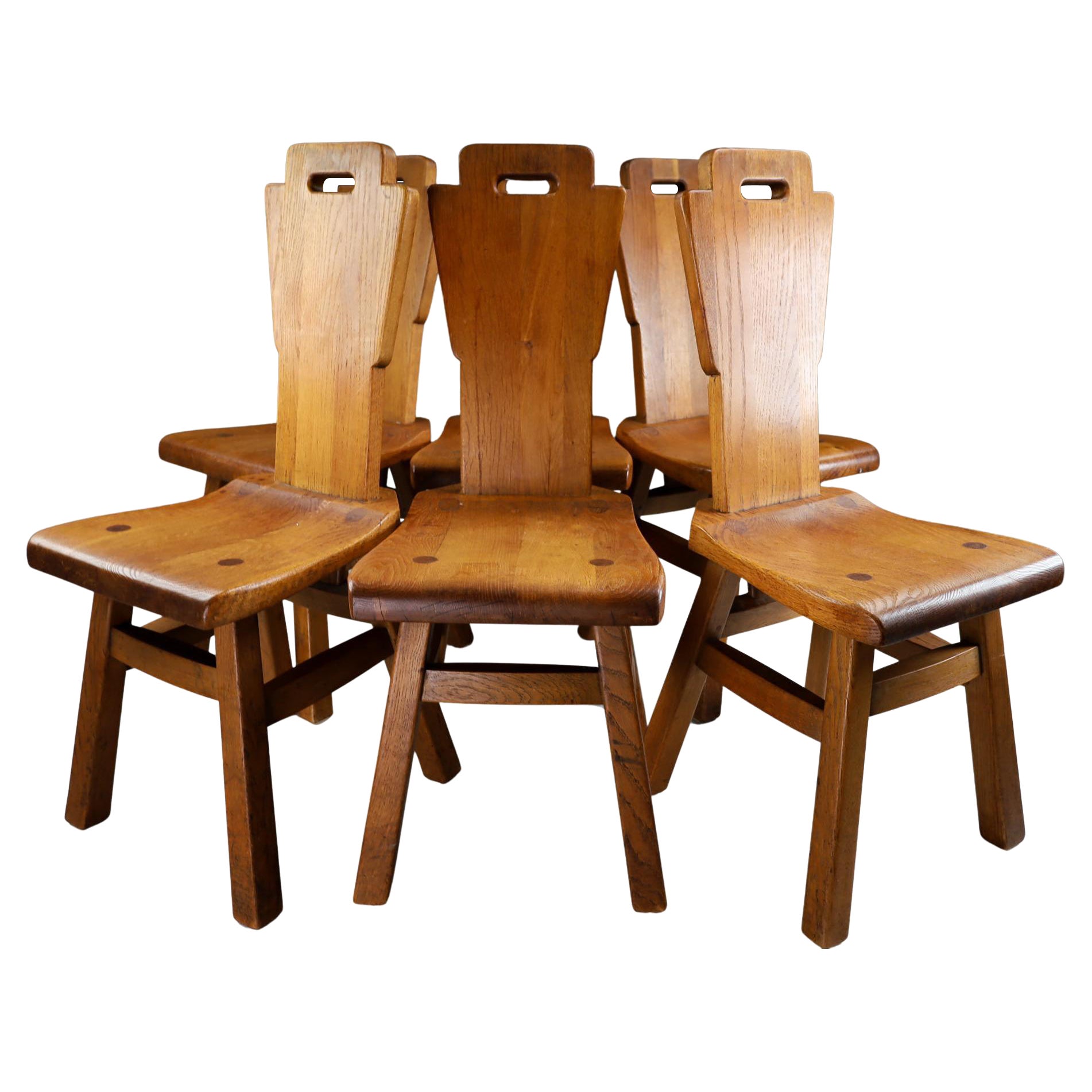Items Similar to French Brutalist massive pine Tree chair, unique, 1950s Handmade, folk art
Want more images or videos?
Request additional images or videos from the seller
1 of 14
French Brutalist massive pine Tree chair, unique, 1950s Handmade, folk art
About the Item
Very unique handmade with massive pine. Unusual chair. The overall is patinated and shows various shades of brown/brownish colors. Elegant and brutalist describe that chair properly. Very strong eye catcher chair.
--------------------------------------------------------------------------------------------------------------------
Brutalist architecture is an architectural style that emerged during the 1950s in the United Kingdom, among the reconstruction projects of the post-war era. Brutalist buildings are characterised by minimalist constructions that showcase the bare building materials and structural elements over decorative design. The style commonly makes use of exposed, unpainted concrete or brick, angular geometric shapes and a predominantly monochrome colour palette; other materials, such as steel, timber, and glass, are also featured.
Descending from the modernist movement, brutalism is said to be a reaction against the nostalgia of architecture in the 1940s. Derived from the Swedish phrase nybrutalism, the term "new brutalism" was first used by British architects Alison and Peter Smithson for their pioneering approach to design. The style was further popularised in a 1955 essay by architectural critic Reyner Banham, who also associated the movement with the French phrases béton brut ("raw concrete") and art brut ("raw art"). The style, as developed by architects such as the Smithsons, Hungarian-born Erno Goldfinger, and the British firm Chamberlin, Powell & Bon, was partly foreshadowed by the modernist work of other architects such as French-Swiss Le Corbusier, Estonian-American Louis Kahn, German-American Mies van der Rohe, and Finnish Alvar Aalto.
In the United Kingdom, brutalism was featured in the design of utilitarian, low-cost social housing influenced by socialist principles and soon spread to other regions around the world. Brutalist designs became most commonly used in the design of institutional buildings, such as universities, libraries, courts, and city halls. The popularity of the movement began to decline in the late 1970s, with some associating the style with urban decay and totalitarianism.
Brutalism has been polarising historically; specific buildings, as well as the movement as a whole, have drawn a range of criticism (often being described as "cold" or "soulless") but have also elicited support from architects and local communities (with many brutalist buildings having become cultural icons, sometimes obtaining listed status). In recent decades, the movement has become a subject of renewed interest. In 2006, several Bostonian architects called for a rebranding of the style to "heroic architecture" to distance it from the negative connotations of the term "brutalism".
- Similar to:José Zanine Caldas (Artist)Pierre Chapo (Designer)
- Dimensions:Height: 33.08 in (84 cm)Width: 14.57 in (37 cm)Depth: 17.72 in (45 cm)Seat Height: 17.52 in (44.5 cm)
- Style:Brutalist (In the Style Of)
- Materials and Techniques:
- Place of Origin:
- Period:
- Date of Manufacture:1950's
- Condition:Wear consistent with age and use. Minor fading. patina.
- Seller Location:Forest, BE
- Reference Number:1stDibs: LU8186235463262
About the Seller
5.0
Gold Seller
These expertly vetted sellers are highly rated and consistently exceed customer expectations.
Established in 2007
1stDibs seller since 2023
18 sales on 1stDibs
Typical response time: 1 hour
- ShippingRetrieving quote...Ships From: Forest, Belgium
- Return PolicyA return for this item may be initiated within 14 days of delivery.
More From This SellerView All
- Swedish Brutalist pine stool, 1950s, HandmadeBy José Zanine Caldas, Axel Einar HjorthLocated in Forest, BEHandmade Swedish stool with massive slasy of pine. It is a rectangular shaped. The joinery is really elegant. The top is patinated and shows various shades of honey tones. Elegant a...Category
Vintage 1950s Swedish Brutalist Stools
MaterialsHardwood, Pine
- French Brutalist Oak Coffee Table, Freeform, 1950s, HandmadeBy José Zanine CaldasLocated in Forest, BEVery unique oak handmade massive slay of tree. It is a free form shape. The top is patinated and shows various shades of brown/brownish colors and honey tones. Elegant and brutalist ...Category
Mid-20th Century French Brutalist Coffee and Cocktail Tables
MaterialsHardwood
- French Brutalist Oak Coffee Table, in the style of Pierre Chapo, 1950s, HandmadeBy Pierre ChapoLocated in Forest, BEVery unique oak handmade massive slays of tree. The top is patinated and shows various shades of brown/brownish colors and honey tones. Elegant and brutalist describe that table properly. The height is 31.5 cm and is 86 cm x 66 cm. Very strong table. Lovely coffee table. -------------------------------------------------------------------------------------------------------------------- Pierre Chapo est né dans le 19e arrondissement de Paris, mais en 1937 la famille s'installe à Vierzon, dans le Cher, le jeune homme s'essaie à la peinture. Puis rencontre en 1947 un charpentier de marine; dans son atelier il découvre le travail du bois, et décide de s'inscrire à l'École nationale supérieure des beaux-arts, section architecture avec Henri Larrieu et Louis Aublet. Les études sont entrecoupées de voyages vers les pays scandinaves, du service militaire en Allemagne, ainsi que d'un périple d'un an en Amérique centrale et un stage dans un cabinet d'architectes en Arizona. De retour en France, Pierre Chapo poursuit le travail du bois essentiellement le chêne, le frêne et l'orme massif qu'il articule avec le double intérêt qu'il porte au design contemporain et au savoir-faire de l'artisanat traditionnel. Après quelques années, il ouvre une galerie boulevard de l'Hôpital, où il expose ses réalisations ainsi que celles d'autres créateurs comme Isamu Noguchi avec lequel il partage une approche sculpturale et organique, il reçoit ses premières commandes parmi lesquelles un lit simple demandé par Samuel Beckett. En 1960, lors de l'exposition Arts et techniques de l'artisanat, son travail est reconnu par la ville de Paris dont il reçoit la Médaille d'or. Puis c'est le développement de l'atelier de fabrication de meubles, à Clamart et la participation à plusieurs projets avec des fabricants et des aménagements avec différents architectes-maitres d’œuvre dont le travail de certains comme Charlotte Perriand pour la station des Arcs l’influencera6 et dont il éditera plus tard une table basse. En 1967, il expose au Salon des artistes décorateurs et remporte la Médaille de bronze de la Société d'encouragement à l'art et à l'industrie9. Cette même année, il s'installe à Gordes et y crée sa société et son usine qui vend et fabrique les meubles audacieux et robustes, en bois massif qu'il dessine, tout en conservant l'atelier de Clamart et la boutique de Paris, étendant son réseau avec des dépositaires à Bruxelles et dans plusieurs villes de France...Category
Mid-20th Century French Brutalist Coffee and Cocktail Tables
MaterialsHardwood
- Swedish Brutalist Tree Trunk Coffee Table, green marble 1940s Handmade UniqueBy Axel VervoordtLocated in Forest, BEVery unique handmade with a tree trunk and a massive slay of green marble. The top is patinated and shows various shades of green colors. Elegant and brutalist describe that table pr...Category
Mid-20th Century Swedish Brutalist Coffee and Cocktail Tables
MaterialsStone, Marble
- Swedish Brutalist Tree Trunk Coffee Table, nice patina 1940s Handmade UniqueBy Axel VervoordtLocated in Forest, BEVery unique handmade with a tree trunk as a feet. The top is patinated and shows various shades of green colors. Elegant and brutalist describe that table properly. The height is 66 ...Category
Mid-20th Century Swedish Brutalist Coffee and Cocktail Tables
MaterialsHardwood
- Pair of French Stained Wooden Stool with circa 1950 BrutalistBy Axel Einar Hjorth, Pierre ChapoLocated in Forest, BECute little French stools. Very strong and good condition. Perfect as footstool or on a side of a sofa or as a side tables. Could be great as nightstands. Very decorative element. S...Category
Mid-20th Century French Brutalist Stools
MaterialsPine
You May Also Like
- Brutalist Art Populaire Mountain Chairs, France, 1950sLocated in Antwerp, BESet of four brutalist mountain chairs, made of solid wood and steeped in the rich history of Auvergne, France, in the 1950s. The sturdy construction of these chairs attests not only ...Category
Vintage 1950s French Brutalist Chairs
MaterialsWood
- Brutalist Monoxylite Chair, France, 1950sLocated in Antwerp, BEBrutalist high-back chair, a statement piece made from solid tree trunk planks. This chair embodies the raw essence of nature, showcasing its rugged beauty and unique textures. The h...Category
Vintage 1950s French Brutalist Chairs
MaterialsWood
- Rough Brutalist Wooden Chair from France, 1950sLocated in Waasmunster, BERough Brutalist wooden chair from France, 1950s.Category
Vintage 1950s French Brutalist Chairs
MaterialsWood
- Solid Oak Dinning Chairs, France, 1950sBy Pierre ChapoLocated in Almelo, NLSet/6 solid oak dinning chairs, France 1950s. These chairs are made of oak and crafted by hand. The craftsmanship is still visible, they are made of solid oak wood and constructed wi...Category
Vintage 1950s Belgian Brutalist Chairs
MaterialsOak
- 6 Brutalist Mountain Chairs, in Pine circa 1950Located in Saint-Ouen, FR6 Brutalist mountain chairs, in pine circa 1950 patina to redo. the price is for one 6 are availableCategory
Vintage 1950s French Brutalist Chairs
MaterialsPine
- Pair of Folk Art Chairs with Tractor Seats, France, 1950sLocated in Isle Sur La Sorgue, VaucluseAlmost-pair of French "homemade" iron chairs with very comfortable! tractor seats. Original paint.Category
Mid-20th Century French Folk Art Chairs
MaterialsIron
Recently Viewed
View AllMore Ways To Browse
Wallpaper Powder Room
Louis Vuitton Leather Seats
White Hanging Chair
Black Shearling Chair
Desk Chair Danish Teak And Leather
S Shaped Wood Base Chair
Century Furniture Kangaroo Chair
Thin Metal Dining Chairs
Plastic Stackable Chair Set Of 4
Wood Rope Chair French
Wickerworks Chair
French Leather And Iron Chair
Brown Leather Accent Chair Vintage
Mid Century Plexiglass Chair
Ron Arad Chairs
Metal Vanity Chair
Used Bubble Chair
Harry Bertoia Chair White





